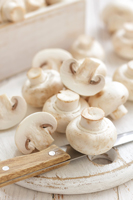Parsley (Petroselinum crispum) can be grown year-round and usually stays green late into the fall and sometimes throughout the winter. The plant can reach six to eight inches in height the first year and up to three feet when it flowers the second. Young foliage is preferred for eating, since the leaves of the second-year growth tend to be somewhat tough and bitter.
While parsley is native to the Mediterranean region, it’s now one of the most widely cultivated garden herbs. In ancient Roman times parsley was a very popular culinary additive. Pliny complained that every sauce and salad contained it. The Romans spread parsley and soft cheese on bread—a predecessor of the modern parsley and cream cheese sandwich.
Parsley is loaded with good nutrition. Like most green vegetables, it’s a good source of vitamin K, vitamin A, folic acid, vitamin C, potassium, fiber, and iron. It boasts a substantial flavonoid content, giving it strong antioxidant potential.
Three Varieties
Parsley appears in three varieties. The most popular form is the tightly curled, green, mossy variety. Then there’s Italian parsley with deeply divided flat leaves that look like those found on celery. Italian parsley has a much stronger flavor than the curly variety. Hamburg parsley grows large white turnip-like roots and tall fern-like leaves that deliver a celery-like flavor. These roots can be grated into salads and soups or cooked like parsnips.
Today parsley is one of the most commonly consumed herbs in America. A fresh sprig of the curled parsley is often used as a garnish, while the Italian parsley flavors many sauces, soups, and stews. Cooks pick the leaves before the plant flowers and serve them fresh, frozen, or dried. In foods, fresh or frozen leaves prove better than dried, as the flavor may be lost during drying.
Special Addition
Parsley can be minced and added to a salad dish, coleslaw, dip, sauce, salad dressing, entrée, or a potato salad. It also infuses special flavors to tomato dishes, baked potatoes, and peas. The stalks—which have a stronger flavor than the leaves—are essential for flavoring casseroles and cooked dishes. To prevent white sauces from becoming discolored, stems are used instead of leaves for flavoring. Parsley is also a major ingredient of tabbouleh, a delicious Lebanese salad.
The leaves of Italian parsley are transformed into parsley flakes. After the stems have been removed, the leaves are dried or dehydrated. The drying process must be done quickly in order to retain the rich green color of the leaves. Twelve pounds of fresh parsley will produce about one pound of parsley flakes.
Therapeutic Uses
Parsley found a home in both traditional Greek and Indian Ayurvedic medicine. Traditionally, it served as an antispasmodic and treated flatulence, dyspepsia, and menstrual disorders.
The leaves and dried root aid in the treatment of gastrointestinal disorders and urinary tract infections. They’re also a mild diuretic. Furthermore, the leaves can be effectively chewed as a breath freshener.
The oil, which is distilled from the leaves and seeds, adds fragrance to soaps, cosmetics, and perfumes.
Parsley used for medicinal purposes is usually the Italian type rather than the curly-leafed variety. The leaves are harvested in the second year of growth, before the plant flowers. The root is harvested in late autumn of the first year of growth or the spring of the second year. Parsley root is often used interchangeably with celery root due to its similar properties.
The usual therapeutic dosage is 2 grams of crushed herb or root placed in a cup of boiling water for 10-15 minutes. This can be taken three times a day for a total of 6 grams of herbal preparation per day. Alterna-tively six capsules a day may be consumed.
Safety Concerns
Parsley is not recommended during pregnancy. The seeds of parsley contain an oil that can cause uterine contractions and may lead to abortion. Parsley should also be avoided by someone with renal disease or who is suffering from an inflamed kidney. The active constituents in the essential oil from parsley seeds include apiol, myristicin, and various terpenoids. These components can cause kidney and liver dysfunction.
Fresh parsley leaves are a colorful addition to any food and make for an enjoyable culinary experience. Fortunately, the herb is easy to grow year-round in the garden, in pots, as an edging, or even indoors.
Winston J. Craig, Ph.D., R.D., is
professor of nutrition at Andrews
University, Berrien Springs, Michigan.



